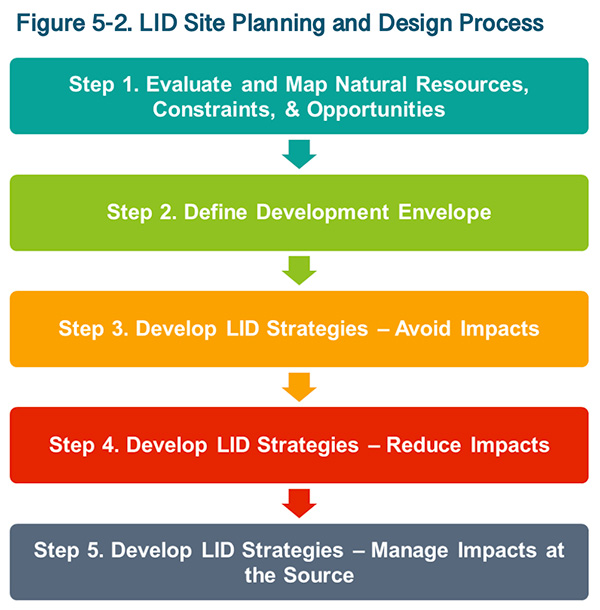Click on the headers for PDF access of these sections of the Manual
Introduction
This chapter addresses the use of Low Impact Development (LID) site planning and design strategies to reduce stormwater runoff volumes and pollutant discharges. LID site planning and design is a non-structural approach for avoiding or reducing the impacts of development on natural site hydrology, which can minimize the need for structural stormwater Best Management Practices (BMPs).
Stormwater Management Standard 1, as described in Chapter 4 - Stormwater Management Standards and Performance Criteria of this Manual, requires project proponents to consider the use of LID site planning and design strategies, to the Maximum Extent Practicable, to reduce and disconnect post-development impervious areas on a site prior to consideration of structural stormwater BMPs. Once LID site planning and design techniques have been considered and applied appropriately, structural stormwater BMPs should be used to retain on-site or treat the remaining required post-development stormwater runoff volume. This approach incorporates LID as the industry standard for all sites and encourages the integration of non-structural LID techniques early in the site planning and design process, consistent with the CT DEEP stormwater general permits.
This chapter provides guidance on the use of LID site planning and design strategies,
including LID credits for common impervious area reduction and disconnection techniques, to help project proponents use these measures to meet the runoff volume and pollutant reduction requirements of Standard 1. Local development regulations and ordinances often dictate the extent to which these strategies can be applied for a particular project. Therefore, communities may need to revise their local land use regulations and ordinances to allow the use of these strategies. This chapter also provides guidance to communities for revising local land use regulations to enable and encourage the use of LID site planning and design strategies.
What is LID?
Summary of what LID is and an overview of the three part objective to avoid, reduce, and manage the adverse impacts of (re)development sites.
Benefits of LID
List of benefits of choosing LID over traditional practices, including reduced consumption of land for Stormwater Management, reduced development costs, and increased property values.
LID Site Planning and Design Techniques
Table containing various techniques for each part of the LID objective.
Avoid Impacts
In-depth information about each technique provided under 'avoiding impacts' such as minimizing soil compaction and site disturbance.
Reduce Impacts
In-depth information about each technique provided under 'reducing impacts', including minimizing creation of new impervious surfaces, preserving the timing of site runoff to approximate pre-development conditions, and the use of low maintenance LID landscaping.
Manage Impacts at the Source
In-depth information about each technique provided under 'managing impacts at the source', to be performed after all efforts to avoid and reduce impacts are exhausted. This objective is focused on managing any remaining stormwater impacts including increases in runoff volume, pollutant loads, and peak flows.
LID Site Planning and Design Process
This section goes through the 5 steps of the LID site planning and design process as highlighted below:

LID Site Planning and Design Applications
Coming applications of LID site planning and design techniques are highlighted both for residential development as well as commercial, industrial, and institutional development.
LID Site Planning and Design Credits
Credits quantify benefits of LID and can be used as incentives. Credit is provided for impervious area conversion and impervious area (simple) disconnection.
Impervious Area Conversion
Summary of the the credit itself and minimum criteria for credit for converting an impervious surface to a pervious surface on a site.
Impervious Area (Simple) Disconnection
Summary of the the credit itself and minimum criteria for credit for redirecting runoff from impervious areas to pervious areas to infiltrate. Specifics are included for roof runoff, driveway, road, and parking lot runoff, as well as solar array runoff.
Additional Information Sources
Additional links are provided for further information on LID BMPs
